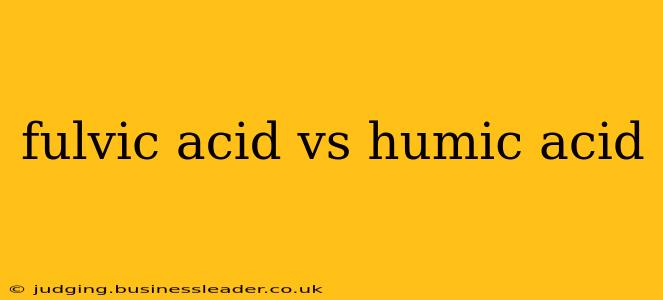Both fulvic acid and humic acid are organic substances found in soil, playing crucial roles in plant health and soil fertility. While often grouped together as humic substances, they possess distinct characteristics and benefits. Understanding their differences is vital for anyone involved in agriculture, gardening, or soil science. This comprehensive guide delves into the specifics of fulvic acid versus humic acid, clarifying their unique properties and applications.
What are Humic and Fulvic Acids?
Before diving into their differences, let's establish a common understanding. Both humic and fulvic acids are naturally occurring organic compounds derived from the decomposition of plant and animal matter. This decomposition process, known as humification, transforms complex organic materials into simpler, more stable substances that enrich the soil. The resulting humic substances are a complex mixture of molecules, with humic acid being the larger and more complex, and fulvic acid being smaller and more readily soluble.
Humic Acid: The Soil's Foundation
Humic acid is the dominant component of humic substances, forming the bulk of the organic matter in soil. Its larger molecular structure makes it less soluble in water, giving it a more solid and gel-like consistency. Humic acid is vital for:
- Improving Soil Structure: It enhances soil aggregation, improving aeration and water retention. This creates a more favorable environment for root growth and nutrient uptake.
- Nutrient Retention: Its negatively charged molecules attract and bind positively charged nutrients like calcium, magnesium, and potassium, preventing leaching and making them more available to plants.
- Cation Exchange Capacity (CEC): Humic acid significantly increases the soil's CEC, a measure of its ability to hold and exchange nutrients. This ensures a consistent supply of essential nutrients for plant growth.
Fulvic Acid: The Soil's Energizer
Fulvic acid, in contrast to humic acid, is a smaller, more soluble molecule. This solubility allows it to penetrate plant cells easily, making it a powerful agent for nutrient delivery and plant stimulation. Key benefits of fulvic acid include:
- Enhanced Nutrient Uptake: Fulvic acid acts as a chelating agent, binding to essential minerals and making them readily available for plant absorption. It essentially acts as a "nutrient shuttle," transporting them directly to the plant's roots.
- Improved Plant Metabolism: It stimulates enzymatic activity within the plant, boosting overall metabolic processes and promoting healthy growth.
- Increased Soil Microbial Activity: Fulvic acid supports a thriving soil microbiome, which is essential for nutrient cycling and overall soil health. A healthy microbiome contributes to stronger plant immunity and resilience.
What are the Key Differences Between Humic and Fulvic Acid?
| Feature | Humic Acid | Fulvic Acid |
|---|---|---|
| Molecular Size | Larger, more complex | Smaller, simpler |
| Solubility | Less soluble in water | Highly soluble in water |
| Color | Dark brown to black | Light yellow to amber |
| Primary Function | Soil structure improvement, nutrient retention | Nutrient uptake enhancement, plant stimulation |
How Do They Work Together?
While distinct, humic and fulvic acids work synergistically in the soil. Humic acid provides the foundational structure and nutrient reservoir, while fulvic acid acts as a facilitator, enhancing nutrient uptake and plant metabolism. Together, they create a dynamic soil ecosystem that supports thriving plant growth.
What are the Benefits of Using Humic and Fulvic Acids?
The benefits extend beyond improved plant growth. Both substances contribute to:
- Increased Crop Yields: By optimizing nutrient availability and plant health, they lead to higher yields and improved crop quality.
- Enhanced Water Retention: Improved soil structure means better water retention, reducing the need for frequent irrigation.
- Reduced Chemical Fertilizer Use: Their nutrient-chelating properties can reduce reliance on synthetic fertilizers.
- Improved Soil Health: They contribute to a healthier, more balanced soil ecosystem.
Where Can I Find Humic and Fulvic Acid Products?
You can find both humic and fulvic acid products in various forms, including liquids, powders, and granules, from agricultural supply stores and online retailers.
Are There Any Side Effects of Using Humic and Fulvic Acids?
Generally, humic and fulvic acids are considered safe for use in agriculture and gardening. However, always follow the manufacturer's instructions and avoid over-application, which could potentially lead to imbalances in the soil.
This exploration provides a solid foundation for understanding the distinctions and applications of fulvic acid and humic acid. By appreciating their individual strengths and their synergistic partnership, you can make informed decisions to optimize soil health and achieve greater success in your gardening or agricultural endeavors.
